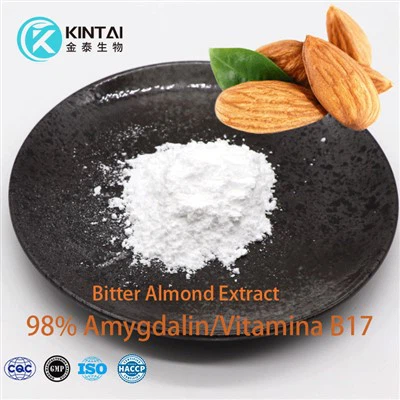1.Products Description
Aconite Root Extract is a pharmaceutical raw material extracted from the plant Aconitum carmichaelii, the main components of which are alkaloids containing toxicity, such as aconitine and highly toxic aconitine. These alkaloids have various pharmacological effects such as analgesic, anti-inflammatory, antibacterial, antiviral and antitumor. KINTAI mainly manufactures 90~99% Lappaconitine Hydrobromide from Aconite Root.
Lappaconitine Hydrobromide is a medical chemical used mainly for the treatment of cardiac arrhythmias, especially ventricular arrhythmias. Its mechanism of action is to slow down the electrical activity of the heart by inhibiting sodium channels and beta receptors, to reduce heart rate and arterial blood pressure to some extent, and to improve symptoms such as arrhythmias.
And aconite extract contains a large number of alkaloids, the main components of which are aconitine and highly toxic aconitine, which have various pharmacological effects such as analgesic, anti-inflammatory, antibacterial and antiviral. It also has some toxicity, which can lead to cardiotoxicity, neurotoxicity and other adverse reactions, so it needs to be used under the guidance of a doctor.

Planting Base of Aconitum sinomontanum Nakai

Roots of Aconitum sinomontanum Nakai

Dried Aconite Root

99%Lappaconitine Hydrobromide
2. Botanic Source
Aconitum carmichaelii is a perennial herb belonging to the genus Aconitum carmichaelii of the buttercup family, native to northeast China and northern China. Its rhizome is cylindrical in shape and is often used in pharmaceuticals or Chinese herbal concoctions and used to make aconitum carmichaelii.
In ancient Chinese medicine, aconitum carmichaelii was widely used to treat rheumatism, epilepsy, neurasthenia and other diseases. However, due to its high toxicity, improper use may cause poisoning, so a set of safe use methods and regulatory measures have been established in modern medicine to ensure the safe and effective use of Aconitum carmichaelii.
KINTAI selected high quality Aconite Root to extract 90%~99% Lappaconitine Hydrobromide.Extract part: Aconite Root
3. Chemical Properties
| CAS Number | 97792-45-5 | Molecular Weight | 665.612 |
| Density | N/A | Boiling Point | 740.8ºC at 760 mmHg |
| Molecular Formula | C32H45BrN2O8 | Melting Point | 223-226ºC |
| Common Name | Lappaconitine Hydrobromide | Flash Point | 401.8ºC |
4. Product quality standard
|
Product name |
Aconite Extract |
|
Extract source |
Aconitum sinomontanum Nakai |
|
Extraction Solvent |
Water/Ethyl alcohol |
|
Appearance |
White Powder |
|
Solubility |
Dissolved in water |
|
Identification |
Titration;HPLC |
|
Sulphated Ash |
NMT 0.5% |
|
Heavy metals |
NMT 20 PPM |
|
Loss On Drying |
NMT 5.0% |
|
Powder size |
80Mesh, NLT90% |
|
Assay |
Min. 98.0% |
|
Microbiological Quality (Total viable aerobic count) |
|
|
- Bacteria, CFU/g, not more than |
NMT 103 |
|
- Moulds and yeasts, CFU/g, not more than |
NMT 102 |
|
- E.coli, Salmonella, S. aureus, CFU/g |
Absence |
|
Storage |
Keep airtight in a cool, dry place, and avoid sunlight. |
|
Shelf life |
Two years |
5. Extraction process

6. Benefits
6.1.Analgesia
The analgesic effect of aconitum aconitum is mostly reported as lappaconitine (LA), the monomer component with the highest content in its roots. Glycine has a significant analgesic effect, and has a significant analgesic effect on a variety of pains such as inflammatory, neuropathic and burn pains.

6.2.anti-inflammatory of Aconite root extract
Experimental research shows that lappaconitine has the effect of anti-acute and chronic inflammation, which provides scientific basis for clinical treatment of pain caused by rheumatoid arthritis and rheumatoid arthritis.
6.3.antiarrhythmic
Lappaconitine has a significant antiarrhythmic effect, belonging to class Ic antiarrhythmic drugs. It can reduce the myocardial contractility and increase the myocardial excitation threshold by blocking the Na+ion channel, resulting in decreased self-discipline and slow conduction to play an antiarrhythmic role.
Both lappaconitine and aconitine belong to typical diterpenoid alkaloids, with the same structure mother nucleus, but different biological activities due to different substituents. While lappaconitine and aconitine have the opposite effect. Aconitine can cause arrhythmia, while lappaconitine shows anti-arrhythmia and can inhibit the arrhythmia induced by aconitine.

6.4. Anti-tumor
Lappaconitine has a killing effect on human non-small cell lung cancer cell line A549. Its mechanism may be related to inducing tumor cell apoptosis, cell cycle arrest, and down-regulating the expression of Cyclin E1.
7. Applications in the medical fields
Lappaconitine Hydrobromide produced by KINTAI is a common drug used in the cardiovascular system, and its main applications include:
7.1.Treatment of ventricular arrhythmias: hypericum hydrobromide blocks abnormal signals of the heart's electrical activity, reducing and preventing the occurrence of ventricular arrhythmias.
7.2.Prevention of arrhythmias: Hypericum hydrobromide can inhibit arrhythmias caused by abnormal increase in heart rate and ensure normal heart rhythm.
7.3.Control of heart rate: Hypericum hydrobromide can have an effect on the heart by reducing the heart rate and controlling the heart rhythm.
7.4.Treatment of hypertension: Homuromycin hydrobromide can effectively lower blood pressure by dilating blood vessels and lowering heart rate, among other effects.
7.5.Treatment of coronary artery disease: Homucoxib hydrobromide can prevent and treat coronary artery disease by increasing blood supply to the heart and improving myocardial ischemia.
It should be noted that although there are various applications of hypericum hydrobromide, there are some potential adverse reactions and contraindications, such as bradycardia, heart failure, abnormal liver function, etc. Therefore, it is necessary to follow the doctor's advice and perform necessary monitoring and examination when using hypericin hydrobromide.
8. Broad Prospect of Aconitum Extract
Aconitum aconitum has become a hot topic in recent years because of its obvious analgesic activity. Clinically, Gaoconitum is mainly used for expelling wind and dampness, regulating qi and relieving pain, promoting blood circulation and dispelling blood stasis, especially for advanced cancer and perioperative pain, and has a good application prospect.
Xi'an Kintai Biotechnology Co., Ltd. focuses on the R&D, production and sales of plant extracts and pharmaceutical intermediates. Improve high-quality high-ugine for you. Our company's philosophy is to do high content and high purity!
Our health care natural products sell well in more than 30 countries including Europe, North America, Australia, Southeast Asia and Russia, and are widely used in medicine, health food, cosmetics, food and beverage, animal feed and other fields.
9. Kintai's production process

10. Why choose Kintai?

11. Kintai manufacturing base
Kintai mainly manufactures 90~99% Lappaconitine Hydrobromide:

12. Kintai R&D center

13.Packing and shipping

TIPS
★If you want to get high-quality High Aconitum Extract, please feel free to contact us at sales@kintaibio.com or feedback on the next page.
Hot Tags: aconite root extract, China aconite root extract manufacturers, suppliers, factory, Black currant fruit extract, Tulsi Extract Powder, Mangifera Indica Leaf Extract, Cassia Tora Extract, Fenugreek Seed Extract Powder, Soapnut Extract













